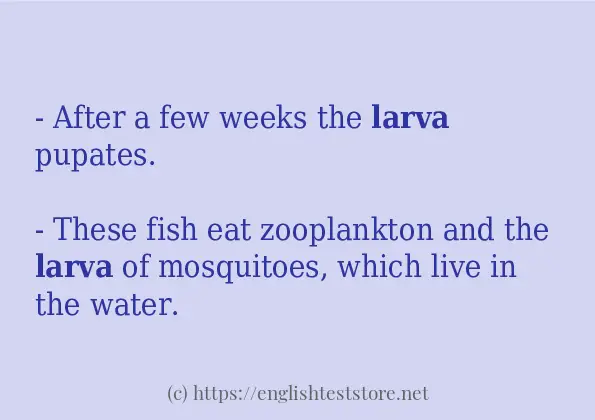How to use in-sentence of “larva”:
– After a few weeks the larva pupates.
– These fish eat zooplankton and the larva of mosquitoes, which live in the water.
– For example, most barnacles moult through six “nauplius” larva stages before moulting to a “cipris”, when they look to settle.
– The cactus spread out of control, but was controlled by the larva of a South American moth.
– A larva egg in those animals.
– Once it finds a host, the larva loses its cilia and develops into a syncytial plasmodium larva.
– However, other wasps have found a way to penetrate this defence and parasitise the larva within.
– The pupa is a special time when the insect is changing into an adult that will look very different from the larva or the pupa.

Example sentences of “larva”:
– The larva looks like a worm and eats and eats so that it can grow much bigger.
– In bees, “royal jelly” provided by worker bees causes a larva to become a queen.
– The virus protects the parasitic larva inside the host by weakening the host’s immune system.
– The female then separates from the feeding stage and attaches herself to another host, where the larva in her develops.
– Because great deal is known about its development from egg to larva to adult, it is a key model for developmental genetics, or evo-devo.
– The egg hatches and a larva comes out.
– This egg then develops into a worm-like larva caterpillar.
– A larva comes out when an egg hatches.
– After some time, the larva turns into a chrysalis.
– Like many sea creatures, a sea squirt larva looks very different from an adult sea squirt.
– This takes twenty to thirty days, while the larva relies on stored resources.
– A beetle larva eats and grows larger until it changes and becomes a pupa.
– The protection is often a noxious chemical, perhaps gained from the larva eating a particulat plant; or it may be a sting or other defence.
– When the larva is ready to pupate, it injects a chemical into the spider.
– When the larva has grown it changes into a pupa.
– The association of specimens of “Xenoturbella” with mollusc larva has led many to suggest that they are molluscivores.
– The larva is the growth stage, the adult is the reproductive stage.
– To help, the queen may bury the larva so that it can spin its cocoon undisturbed.
- The larva looks like a worm and eats and eats so that it can grow much bigger.
- In bees, "royal jelly" provided by worker bees causes a larva to become a queen.
